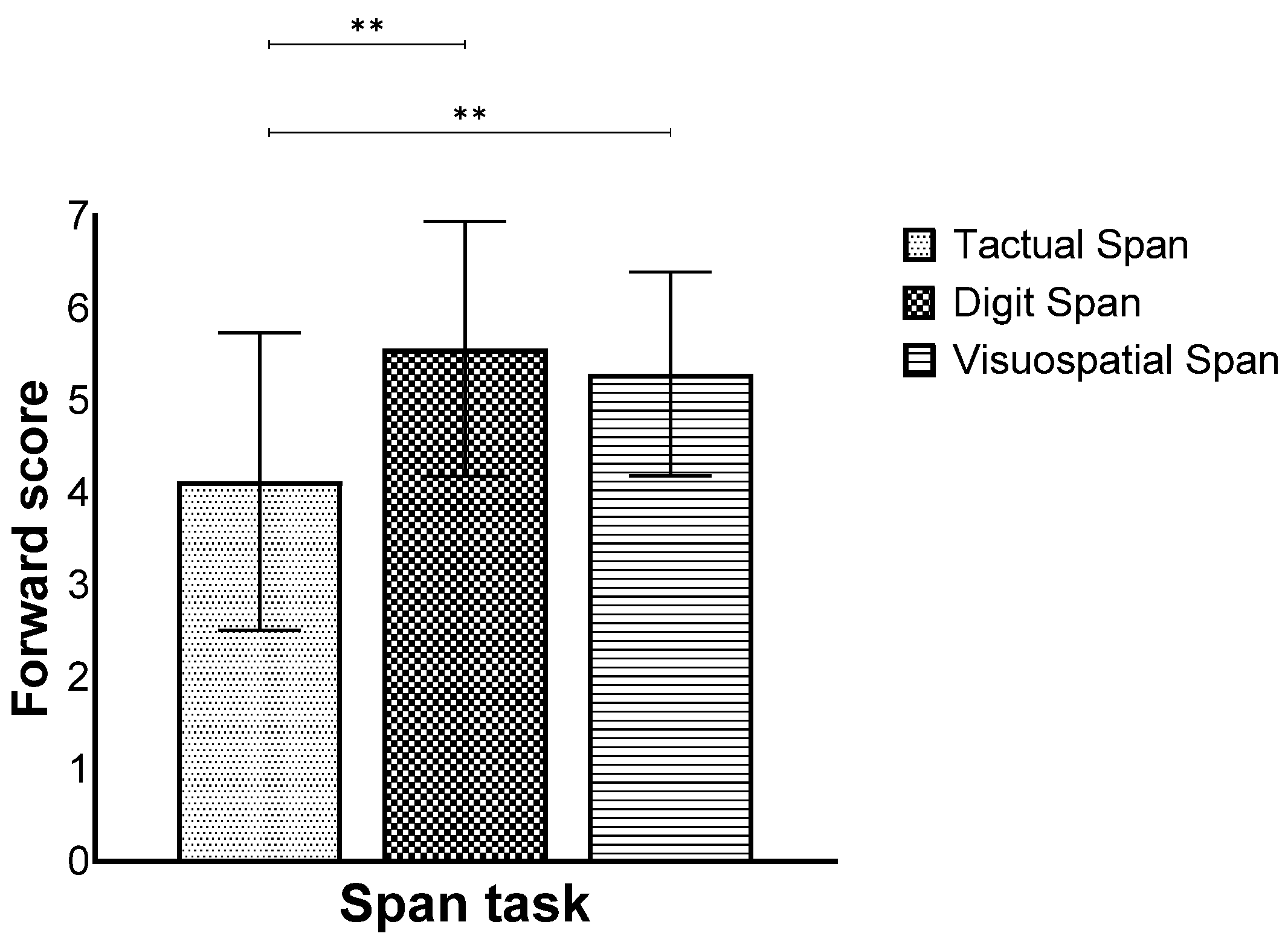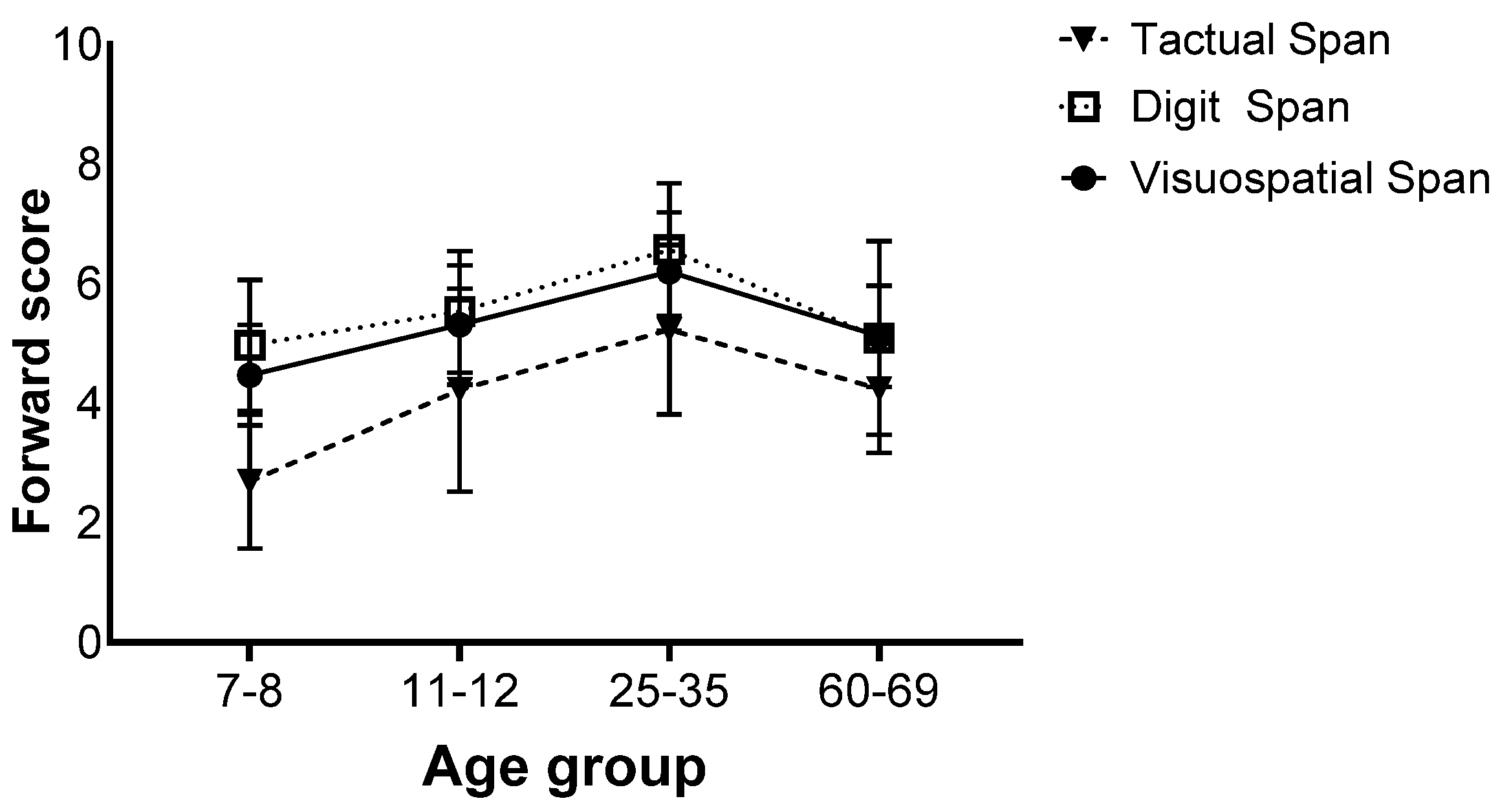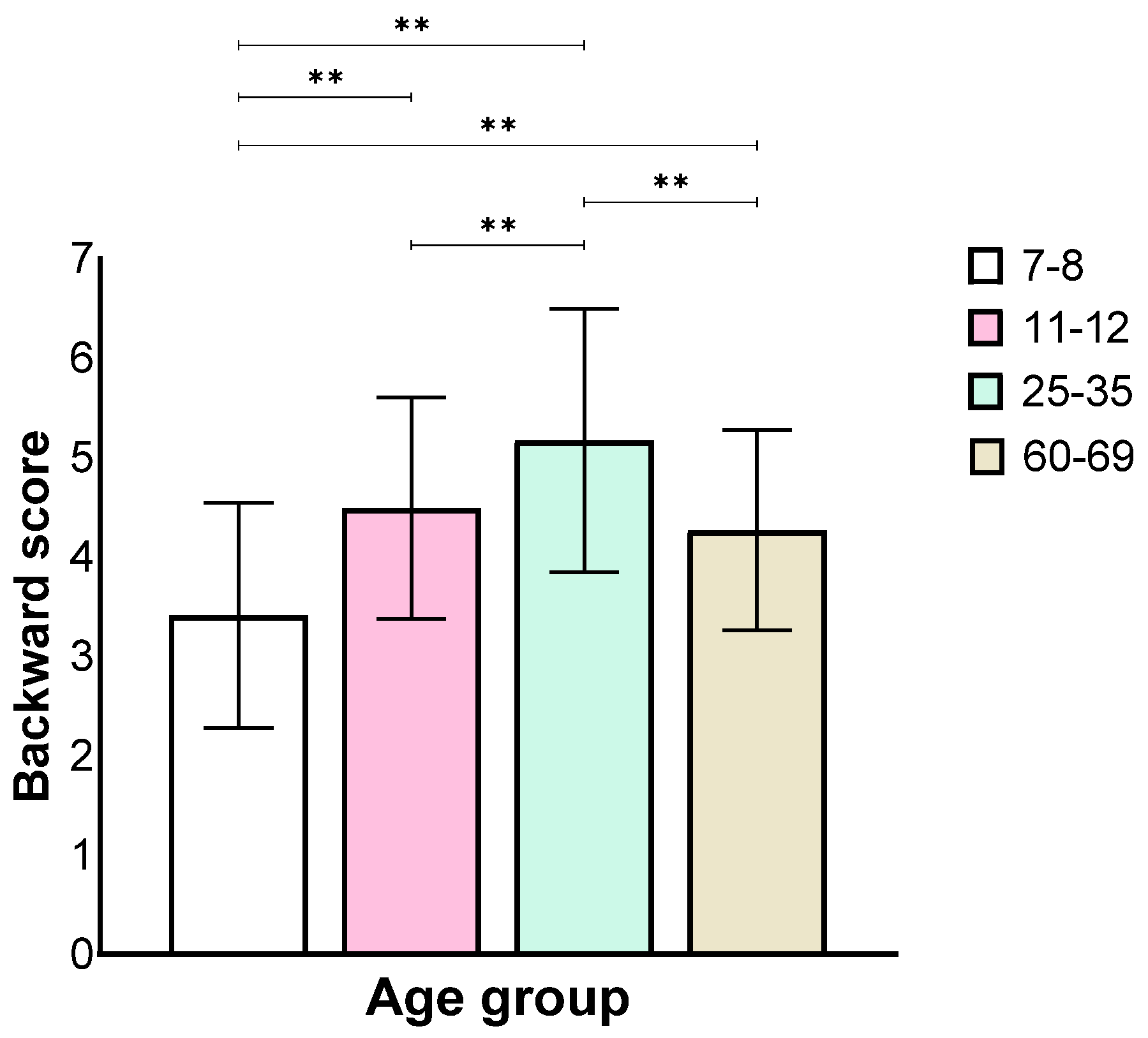Aging’s Effect on Working Memory—Modality Comparison
Abstract
:1. Introduction
2. Materials and Methods
2.1. Participants
2.2. Instruments and Measures
2.2.1. Demographic and Clinical Questionnaire
2.2.2. Tactual Span
2.2.3. Digit Span
2.2.4. Visuospatial Span
2.3. Procedure
2.4. Statistical Analysis
3. Results
4. Discussion
Author Contributions
Funding
Institutional Review Board Statement
Informed Consent Statement
Data Availability Statement
Conflicts of Interest
References
- Courtney, S.M. Working memory is a distributed dynamic process. Cogn. Neurosci. 2022, 13, 208–209. [Google Scholar] [CrossRef]
- Kamiński, J. Intermediate-term memory as a bridge between working and long-term memory. J. Neurosci. 2017, 37, 5045–5047. [Google Scholar] [CrossRef]
- Tariq, S.; Noor, S. Impact of Working Memory on Academic Achievement of University Science Students in Punjab, Pakistan. J. Educ. Pract. 2012, 3, 72–78. [Google Scholar]
- Baddeley, A. Working Memory: Theories, Models, and Controversies. Annu. Rev. Psychol. 2012, 63, 1–29. [Google Scholar] [CrossRef] [PubMed]
- Guida, A.; Megreya, A.M.; Lavielle-Guida, M.; Noël, Y.; Mathy, F.; van Dijck, J.P.; Abrahamse, E. Spatialization in working memory is related to literacy and reading direction: Culture “literarily” directs our thoughts. Cognition 2018, 175, 96–100. [Google Scholar] [CrossRef] [PubMed]
- Heled, E.; Elul, N.; Ptito, M.; Chebat, D.R. Deductive Reasoning and Working Memory Skills in Individuals with Blindness. Sensors 2022, 22, 2062. [Google Scholar] [CrossRef]
- Vernucci, S.; Aydmune, Y.; Andrés, M.L.; Burin, D.I.; Canet-Juric, L. Working memory and fluid intelligence predict reading comprehension in school-age children: A one-year longitudinal study. Appl. Cogn. Psychol. 2021, 35, 1115–1124. [Google Scholar] [CrossRef]
- Baddeley, A. The episodic buffer: A new component of working memory? Trends Cogn. Sci. 2000, 4, 417–423. [Google Scholar] [CrossRef]
- Baddeley, A.; Hitch, G.J. Working Memory. In The Psychology of Learning and Motivation; Bower, G.A., Ed.; Academic Press: Cambridge, MA, USA, 1974; pp. 47–89. [Google Scholar]
- Gathercole, S.E.; Pickering, S.J.; Ambridge, B.; Wearing, H. The Structure of Working Memory from 4 to 15 Years of Age. Dev. Psychol. 2004, 40, 177–190. [Google Scholar] [CrossRef]
- Swanson, H.L. Verbal and visual-spatial working memory: What develops over a life Span? Dev. Psychol. 2017, 53, 971–995. [Google Scholar] [CrossRef]
- Vernucci, S.; Canet-Juric, L.; Zamora, E.V.; Richard’s, M.M. The structure of working memory during childhood: A systematic review. J. Cogn. Psychol. 2021, 33, 103–118. [Google Scholar] [CrossRef]
- Borella, E.; Carretti, B.; De Beni, R. Working memory and inhibition across the adult life-span. Acta Psychol. 2008, 128, 33–44. [Google Scholar] [CrossRef] [PubMed]
- Krogsrud, S.K.; Mowinckel, A.M.; Sederevicius, D.; Vidal-Piñeiro, D.; Amlien, I.K.; Wang, Y.; Sørensen, Ø.; Walhovd, K.B.; Fjell, A.M. Relationships between apparent cortical thickness and working memory across the lifespan—Effects of genetics and socioeconomic status. Dev. Cogn. Neurosci. 2021, 51, 100997. [Google Scholar] [CrossRef]
- Grégoire, J.; Van der Linden, M. Effect of age on forward and backward digit spans. Aging Neuropsychol. Cogn. 1997, 4, 140–149. [Google Scholar] [CrossRef]
- Salthouse, T.A. What cognitive abilities are involved in trail-making performance? Intelligence 2011, 39, 222–232. [Google Scholar] [CrossRef]
- Alloway, T.P.; Alloway, R.G. Working memory across the lifespan: A cross-sectional approach. J. Cogn. Psychol. 2013, 25, 84–93. [Google Scholar] [CrossRef]
- Kumar, N.; Priyadarshi, B. Differential effect of aging on verbal and visuo-spatial working memory. Aging Dis. 2013, 4, 170–177. Available online: https://pubmed.ncbi.nlm.nih.gov/23946892/ (accessed on 15 April 2023). [PubMed]
- Park, D.C.; Lautenschlager, G.; Hedden, T.; Davidson, N.S.; Smith, A.D.; Smith, P.K. Models of visuospatial and verbal memory across the adult life span. Psychol. Aging 2002, 17, 299–320. [Google Scholar] [CrossRef] [PubMed]
- Cansino, S.; Hernández-Ramos, E.; Estrada-Manilla, C.; Torres-Trejo, F.; Martínez-Galindo, J.G.; Ayala-Hernández, M.; Gómez-Fernández, T.; Osorio, D.; Cedillo-Tinoco, M.; Garcés-Flores, L.; et al. The decline of verbal and visuospatial working memory across the adult life span. Age 2013, 35, 2283–2302. [Google Scholar] [CrossRef]
- Vuontela, V.; Steenari, M.; Carlson, S.; Fjällberg, M.; Aronen, E.T.; Koivisto, J. Audiospatial and Visuospatial Working Memory in 6–13 Year Old School Children. Learn. Mem. 2003, 10, 74–81. [Google Scholar] [CrossRef]
- Jenkins, L.; Myerson, J.; Hale, S.; Fry, A.F. Individual and developmental differences in working memory across the life span. Psychon. Bull. Rev. 1999, 6, 28–40. [Google Scholar] [CrossRef] [PubMed]
- Jenkins, L.; Myerson, J.; Joerding, J.A.; Hale, S. Converging evidence that visuospatial cognition is more age-sensitive than verbal cognition. Psychol. Aging 2000, 15, 157–175. [Google Scholar] [CrossRef] [PubMed]
- Jockwitz, C.; Caspers, S.; Lux, S.; Jütten, K.; Schleicher, A.; Eickhoff, S.B.; Amunts, K.; Zilles, K. Age- and function-related regional changes in cortical folding of the default mode network in older adults. Brain Struct. Funct. 2017, 222, 83–99. [Google Scholar] [CrossRef] [PubMed]
- Bliss, I.; Hämäläinen, H. Different working memory capacity in normal young adults for visual and tactile letter recognition task. Scand. J. Psychol. 2005, 46, 247–251. [Google Scholar] [CrossRef] [PubMed]
- Cohen, H.; Voss, P.; Lepore, F.; Scherzer, P. The Nature of Working Memory for Braille. PLoS ONE 2010, 5, e10833. [Google Scholar] [CrossRef] [PubMed]
- Bliss, I.; Kujala, T.; Hämäläinen, H. Comparison of blind and sighted participants’ performance in a letter recognition working memory task. Cogn. Brain Res. 2004, 18, 273–277. [Google Scholar] [CrossRef] [PubMed]
- Heled, E.; Rotberg, S.; Yavich, R.; Hoofien, A.D. Introducing the Tactual Span: A New Task for Assessing Working Memory in the Teactile Modality. Assessment 2020, 28, 1018–1031. [Google Scholar] [CrossRef]
- Ricciardi, E.; Bonino, D.; Gentili, C.; Sani, L.; Pietrini, P.; Vecchi, T. Neural correlates of spatial working memory in humans: A functional magnetic resonance imaging study comparing visual and tactile processes. Neuroscience 2006, 139, 339–349. [Google Scholar] [CrossRef]
- Heled, E.; Israeli, R.; Margalit, D. Working memory development in different modalities in children and young adults. J. Exp. Child Psychol. 2022, 220, 105422. [Google Scholar] [CrossRef]
- Picard, D.; Monnier, C. Short-term memory for spatial configurations in the tactile modality: A comparison with vision. Memory 2009, 17, 789–801. [Google Scholar] [CrossRef]
- Faul, F.; Erdfelder, E.; Lang, A.; Buchner, A. A flexible statistical power analysis program for the social, behavioral, and biomedical sciences. Behav. Res. Methods 2007, 39, 175–191. [Google Scholar] [CrossRef]
- Wechsler, D. Wechsler Adult Intelligence Scale, 3rd ed.; Psychological Corporation: Agra, India, 1997. [Google Scholar]
- Corsi, P.M. Human Memory and the Medial Temporal Region of the Brain. Unpublished Ph.D. Thesis, McGill University, Montreal, QC, Canada, 1972. [Google Scholar]
- Conklin, H.M.; Luciana, M.; Hooper, C.J.; Yarger, R.S. Working memory performance in typically developing children and adolescents: Behavioral evidence of protracted frontal lobe development. Dev. Neuropsychol. 2007, 31, 103–128. [Google Scholar] [CrossRef] [PubMed]
- Frampton, I.; Hutchinson, A.; Watkins, B.; Lask, B. Neurobiological status at initial presentation predicts neuropsychological functioning in early onset anorexia nervosa at four-year follow up. Dev. Neuropsychol. 2012, 37, 76–83. [Google Scholar] [CrossRef]
- Luciana, M.; Conklin, H.M.; Hooper, C.J.; Yarger, R.S. The development of nonverbal working memory and executive control processes in adolescents. Child Dev. 2005, 76, 697–712. [Google Scholar] [CrossRef] [PubMed]
- McAuley, T.; White, D.A. A latent variables examination of processing speed, response inhibition, and working memory during typical development. J. Exp. Child Psychol. 2011, 108, 453–468. [Google Scholar] [CrossRef]
- Cowan, N. The many faces of working memory and short-term storage. Psychon. Bull. Rev. 2017, 24, 1158–1170. [Google Scholar] [CrossRef]
- Plebanek, D.J.; Sloutsky, V.M. Selective attention, filtering, and the development of working memory. Dev. Sci. 2019, 22, e12727. [Google Scholar] [CrossRef] [PubMed]
- Bathelt, J.; Gathercole, S.E.; Johnson, A.; Astle, D.E. Differences in brain morphology and working memory capacity across childhood. Dev. Sci. 2018, 21, e12579. [Google Scholar] [CrossRef]
- Chai, W.J.; Ismafairus, A.; Hamid, A.; Abdullah, J.M.; Elliott, E.M. Working Memory from the Psychological and Neurosciences Perspectives: A Review. Front. Psychol. 2018, 9, 401. [Google Scholar] [CrossRef]
- Klingberg, T. Development of a superior frontal-intraparietal network for visuo-spatial working memory. Neuropsychologia 2006, 44, 2171–2177. [Google Scholar] [CrossRef]
- Li, S.C.; Rieckmann, A. Neuromodulation and aging: Implications of aging neuronal gain control on cognition. Curr. Opin. Neurobiol. 2014, 29, 148–158. [Google Scholar] [CrossRef] [PubMed]
- Reuter-Lorenz, P.A.; Jonides, J.; Smith, E.E.; Hartley, A.; Miller, A.; Marshuetz, C.; Koeppe, R.A. Age differences in the frontal lateralization of verbal and spatial working memory revealed by PET. J. Cogn. Neurosci. 2000, 12, 174–187. [Google Scholar] [CrossRef] [PubMed]
- Krogsrud, S.K.; Fjell, A.M.; Tamnes, C.K.; Grydeland, H.; Due-Tønnessen, P.; Bjørnerud, A.; Sampaio-Baptista, C.; Andersson, J.; Johansen-Berg, H.; Walhovd, K.B. Development of white matter microstructure in relation to verbal and visuospatial working memory—A longitudinal study. PLoS ONE 2018, 13, e0195540. [Google Scholar] [CrossRef] [PubMed]
- Kumar, R.; Indrayan, A. Receiver operating characteristic (ROC) curve for medical researchers. Indian Pediatr. 2011, 48, 277–287. [Google Scholar] [CrossRef] [PubMed]
- Cohen, H.; Scherzer, P.; Viau, R.; Voss, P.; Lepore, F. Working memory for braille is shaped by experience. Commun. Integr. Biol. 2011, 4, 227–229. [Google Scholar] [CrossRef] [PubMed]
- Heled, E.; Ohayon, M.; Oshri, O. Working memory in intact modalities among individuals with sensory deprivation. Heliyon 2022, 8, e09558. [Google Scholar] [CrossRef] [PubMed]
- Heled, E.; Ohayon, M. Visuospatial and Tactile Working Memory in Individuals with Congenital Deafness. J. Deaf. Stud. Deaf. Educ. 2021, 26, 314–321. [Google Scholar] [CrossRef] [PubMed]
- Reynolds, C. Forward and backward memory span should not be combined for clinical analysis. Arch. Clin. Neuropsychol. 1997, 12, 29–40. [Google Scholar] [CrossRef] [PubMed]
- Snyder, H.R.; Miyake, A.; Hankin, B.L. Advancing understanding of executive function impairments and psychopathology: Bridging the gap between clinical and cognitive approaches. Front. Psychol. 2015, 6, 328. [Google Scholar] [CrossRef]
- Alloway, T.P.; Gathercole, S.E.; Pickering, S.J. Verbal and visuospatial short-term and working memory in children: Are they separable? Child Dev. 2006, 77, 1698–1716. [Google Scholar] [CrossRef]
- Koppenol-Gonzalez, G.V.; Bouwmeester, S.; Vermunt, J.K. The development of verbal and visual working memory processes: A latent variable approach. J. Exp. Child Psychol. 2012, 111, 439–454. [Google Scholar] [CrossRef] [PubMed]
- Proekt, Y.; Khoroshikh, V.; Kosheleva, A.; Lugovaya, V.; Piskunova, E. Digital experience and cognitive development in primary school students. In Proceedings of the 2020 International Conference “Internet and Modern Society”, Virtual, 17–20 June 2020. [Google Scholar]
- Twenge, J.M.; Campbell, W.K. Associations between screen time and lower psychological well-being among children and adolescents: Evidence from a population-based study. Prev. Med. Rep. 2018, 12, 271–283. [Google Scholar] [CrossRef] [PubMed]
- Kaas, A.L.; van Mier, H.; Visser, M.; Goebel, R. The neural substrate for working memory of tactile surface texture. Hum. Brain Mapp. 2013, 34, 1148–1162. [Google Scholar] [CrossRef]






| 7–8 | 11–12 | 25–35 | 60–69 | |
|---|---|---|---|---|
| Age | 7.94 (0.43) | 11.75 (0.44) | 29.53 (3.23) | 64.41 (2.87) |
| Years of education | 2.38 (0.79) | 6.06 (0.24) | 15.25 (1.62) | 14.47 (2.21) |
Disclaimer/Publisher’s Note: The statements, opinions and data contained in all publications are solely those of the individual author(s) and contributor(s) and not of MDPI and/or the editor(s). MDPI and/or the editor(s) disclaim responsibility for any injury to people or property resulting from any ideas, methods, instructions or products referred to in the content. |
© 2024 by the authors. Licensee MDPI, Basel, Switzerland. This article is an open access article distributed under the terms and conditions of the Creative Commons Attribution (CC BY) license (https://creativecommons.org/licenses/by/4.0/).
Share and Cite
Heled, E.; Levi, O. Aging’s Effect on Working Memory—Modality Comparison. Biomedicines 2024, 12, 835. https://doi.org/10.3390/biomedicines12040835
Heled E, Levi O. Aging’s Effect on Working Memory—Modality Comparison. Biomedicines. 2024; 12(4):835. https://doi.org/10.3390/biomedicines12040835
Chicago/Turabian StyleHeled, Eyal, and Ohad Levi. 2024. "Aging’s Effect on Working Memory—Modality Comparison" Biomedicines 12, no. 4: 835. https://doi.org/10.3390/biomedicines12040835





